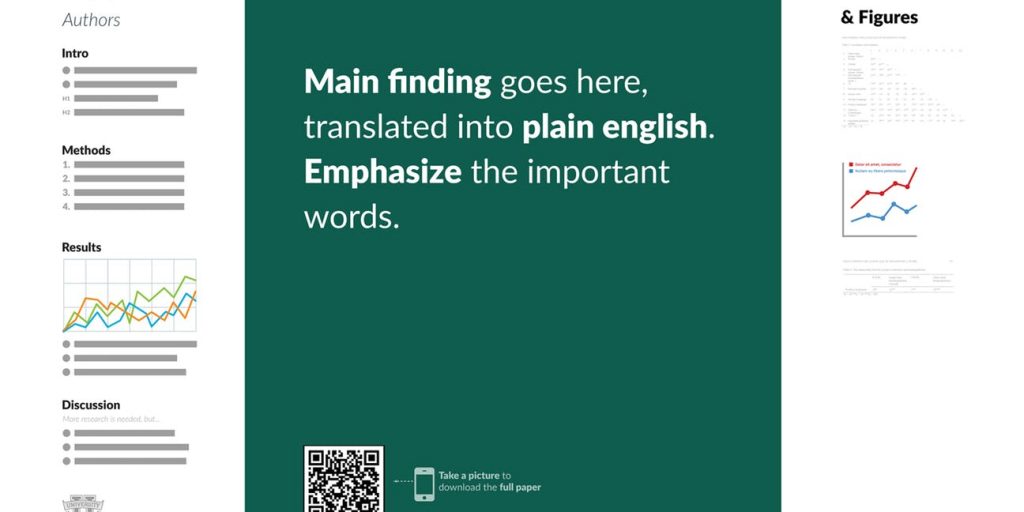From retrievalpractice.org regarding the “Make it Stick” book, this link includes:
- Discussion questions for each chapter
- Sketchnotes for each chapter
- Additional readings and research articles




From retrievalpractice.org regarding the “Make it Stick” book, this link includes:
A New Way Forward: CAEL Association Update (August 2019) –from evolllution.com by Marie Cini | President, CAEL
As the labor market continues to evolve, CAEL will play a critical role in establishing a collaborative ecosystem linking learners, employers and postsecondary institutions.
Excerpt:
I’m delighted to announce a new partnership between CAEL and The EvoLLLution to deliver timely information on the latest advances related to serving adult working learners. When you consider the rapidly changing nature of the work our members face, it’s hard to imagine a more aptly named organization to collaborate with!
This partnership will provide CAEL members with fresh thinking twice a month in the form of a brief digital newsletter. The focus will be on lifelong learning and transforming traditional structures to better meet the needs of today’s working learners in communities, across industries, inside all postsecondary institutions.
“What if neither distance nor language mattered? What if technology could help you be anywhere you need to be and speak any language? Using AI technology and holographic experiences this is possible, and it is revolutionary.”
Also see:
Microsoft has a wild hologram that translates HoloLens keynotes into Japanese — from theverge.com by Tom Warren
Azure and HoloLens combine for a hint at the future
Excerpt:
Microsoft has created a hologram that will transform someone into a digital speaker of another language. The software giant unveiled the technology during a keynote at the Microsoft Inspire partner conference [on 7/17/19] in Las Vegas. Microsoft recently scanned Julia White, a company executive for Azure, at a Mixed Reality capture studio to transform her into an exact hologram replica.
The digital version appeared onstage to translate the keynote into Japanese. Microsoft has used its Azure AI technologies and neural text-to-speech to make this possible. It works by taking recordings of White’s voice, in order to create a personalized voice signature, to make it sound like she’s speaking Japanese.
Clay Shirky on Mega-Universities and Scale — from philonedtech.com by Clay Shirky
[This was a guest post by Clay Shirky that grew out of a conversation that Clay and Phil had about IPEDS enrollment data. Most of the graphs are provided by Phil.]
Excerpts:
Were half a dozen institutions to dominate the online learning landscape with no end to their expansion, or shift what Americans seek in a college degree, that would indeed be one of the greatest transformations in the history of American higher education. The available data, however, casts doubt on that idea.
Though much of the conversation around mega-universities is speculative, we already know what a mega-university actually looks like, one much larger than any university today. It looks like the University of Phoenix, or rather it looked like Phoenix at the beginning of this decade, when it had 470,000 students, the majority of whom took some or all of their classes online. Phoenix back then was six times the size of the next-largest school, Kaplan, with 78,000 students, and nearly five times the size of any university operating today.
From that high-water mark, Phoenix has lost an average of 40,000 students every year of this decade.
From DSC:
First of all, I greatly appreciate both Clay’s and Phil’s thought leadership and their respective contributions to education and learning through the years. I value their perspectives and their work. Clay and Phil offer up a great article here — one worth your time to read.
The article made me reflect on what I’ve been building upon and tracking for the last decade — a next generation ***PLATFORM*** that I believe will represent a powerful piece of a global learning ecosystem. I call this vision, “Learning from the Living [Class] Room.” Though the artificial intelligence-backed platform that I’m envisioning doesn’t yet fully exist — this new era and type of learning-based platform ARE coming. The emerging signs, technologies, trends — and “fingerprints”of it, if you will — are beginning to develop all over the place.
Such a platform will:
…
Below are some quotes that I want to comment on:
Not nothing, but not the kind of environment that will produce an educational Amazon either, especially since the top 30 actually shrank by 0.2% a year.
Instead of an “Amazon vs. the rest” dynamic, online education is turning into something much more widely adopted, where the biggest schools are simply the upper end of a continuum, not so different from their competitors, and not worth treating as members of a separate category.
Since the founding of William and Mary, the country’s second college, higher education in the U.S. hasn’t been a winner-take-all market, and it isn’t one today. We are not entering a world where the largest university operates at outsized scale, we’re leaving that world;
From DSC:
I don’t see us leaving that world at all…but that’s not my main reflection here. Instead, I’m not focusing on how large the mega-universities will become. When I speak of a forthcoming Walmart of Education or Amazon of Education, what I have in mind is a platform…not one particular organization.
Consider that the vast majority of Amazon’s revenues come from products that other organizations produce. They are a platform, if you will. And in the world of platforms (i.e., software), it IS a winner take all market.
Bill Gates reflects on this as well in this recent article from The Verge:
“In the software world, particularly for platforms, these are winner-take-all markets.
So it’s all about a forthcoming platform — or platforms. (It could be more than one platform. Consider Apple. Consider Microsoft. Consider Google. Consider Facebook.)
But then the question becomes…would a large amount of universities (and other types of organizations) be willing to offer up their courses on a platform? Well, consider what’s ALREADY happening with FutureLearn:
Finally…one more excerpt from Clay’s article:
Eventually the new ideas lose their power to shock, and end up being widely copied. Institutional transformation starts as heresy and ends as a section in the faculty handbook.
From DSC:
This is a great point. Reminds me of this tweet from Fred Steube (and I added a piece about Western Telegraph):
Why would anyone need a telephone when we already have the telegraph? [Western Telegraph] https://t.co/s6Rm67NAB0
— Daniel Christian (@dchristian5) May 23, 2019
Some things to reflect upon…for sure.
Research Posters Are a Staple of Academic Conferences. Could a New Design Speed Discovery? — from edsurge.com by Jeff Young
Excerpts:
Scholars around the world share their latest research findings with a decidedly low-tech ritual: printing a 48-inch by 36-inch poster densely packed with charts, graphs and blocks of text describing their research hypothesis, methods and findings. Then they stand with the poster in an exhibit hall for an hour, surrounded by rows of other researchers presenting similar posters, while hundreds of colleagues from around the world walk by trying to skim the displays.
…
Not only does the exercise deflate the morale of the scholars sharing posters, the ritual is incredibly inefficient at communicating science, Morrison argues.
…
Morrison says he has a solution: A better design for those posters, plus a dash of tech.
To make up for all the nuance and detail lost in this approach, the template includes a QR code that viewers can scan to get to the full research paper.
From DSC:
Wouldn’t this be great if more journal articles would do the same thing? That is, give us the key findings, conclusions (with some backbone to them), and recommendations right away! Abstracts don’t go far enough, and often scholars/specialists are talking amongst themselves…not to the world. They could have a far greater reach/impact with this kind of approach.
(The QR code doesn’t make as much sense if one is already reading the full journal article…but the other items make a great deal of sense!)
Coursera raises $103 million to prepare online learners for the ‘fourth industrial revolution’ — from venturebeat.com by Paul Sawers
Excerpts (emphasis DSC):
Founded in 2012, Coursera is one of a number of well-funded MOOCs — massive open online courses — to emerge. Coursera partners with universities and other educational institutions to deliver online courses to 40 million students, covering subjects like technology, business, science, and even autonomous cars.
…
“The fourth industrial revolution, marked by advancements in automation and artificial intelligence, is dramatically reshaping our lives, businesses, and jobs,” noted Coursera CEO Jeff Maggioncalda. “Coursera is at the forefront of preparing individuals, companies, and governments to meet that challenge head-on and turn this disruption into opportunity. The additional funding gives us the resources and flexibility to further expand internationally and to accelerate the development of a learning platform that currently serves 40 million learners, 1,800 businesses, and over 150 top universities.”
Minerva’s Innovative Platform Makes Quality Higher Ed Personal and Affordable — from linkedin.com by Tom Vander Ark
Excerpt:
The first external partner, the Hong Kong University of Science and Technology (HKUST), loved the course design and platform but told Nelson they couldn’t afford to teach 15 students at a time. The Minerva team realized that to be applicable at major universities, active learning needed to be scalable.
Starting this summer, a new version of Forum will be available for classes of up to 400 at a time. For students, it will still feel like a small seminar. They’ll see the professor, themselves, and a dozen other students. Forum will manage the movement of students from screen to screen. “Everybody thinks they are in the main room,” said Nelson.
…
Forum enables real-time polling and helps professors create and manage breakout groups.
…
Big Implications
With Forum, “For the first time you can deliver better than Ivy League education at absurdly low cost,” said Nelson.
Online courses and MOOCs just repackaged the same format and just offered it with less interaction. As new Forum partners will demonstrate, “It’s possible to deliver a year of undergraduate education that is vastly superior for under $5,000 per student,” added Nelson.
He’s excited to offer a turnkey university solution that, for partners like Oxford Teachers Academy, will allow new degree pathways for paraprofessionals that can work, learn, and earn a degree and certification.
Perhaps another piece of the puzzle is falling into place…
The Growing Profile of Non-Degree Credentials: Diving Deeper into ‘Education Credentials Come of Age’ — from evolllution.com by Sean Gallagher
Higher education is entering a “golden age” of lifelong learning and that will mean a spike in demand for credentials. If postsecondary institutions want to compete in a crowded market, they need to change fast.
Excerpts (emphasis DSC):
One of the first levels of opportunity is simply embedding the skills that are demanded in the job market into educational programs. Education certainly has its own merits independent of professional outcomes. But critics of higher education who suggest graduates aren’t prepared for the workforce have a point in terms of the opportunity for greater job market alignment, and less of an “ivory tower” mentality at many institutions. Importantly, this does not mean that there isn’t value in the liberal arts and in broader ways of thinking—problem solving, leadership, critical thinking, analysis, and writing are among the very top skills demanded by employers across all educational levels. These are foundational and independent of technical skills.
The second opportunity is building an ecosystem for better documentation and sharing of skills—in a sense what investor Ryan Craig has termed a “competency marketplace.” Employers’ reliance on college degrees as relatively blunt signals of skill and ability is partly driven by the fact that there aren’t many strong alternatives. Technology—and the growth of platforms like LinkedIn, ePortfolios and online assessments—is changing the game. One example is digital badges, which were originally often positioned as substitutes to degrees or certificates.
Instead, I believe digital badges are a supplement to degrees and we’re increasingly seeing badges—short microcredentials that discretely and digitally document competency—woven into degree programs, from the community college to the graduate degree level.
However, it is becoming increasingly clear that the market is demanding more “agile” and shorter-form approaches to education. Many institutions are making this a strategic priority, especially as we read the evolution of trends in the global job market and soon enter the 2020s.
Online education—which in all its forms continues to slowly and steadily grow its market share in terms of all higher ed instruction—is certainly an enabler of this vision, given what we know about pedagogy and the ability to digitally document outcomes.
In addition, 64 percent of the HR leaders we surveyed said that the need for ongoing lifelong learning will demand higher levels of education and more credentials in the future.
Along these lines of online-based collaboration and learning,
go to the 34 minute mark of this video:
From DSC:
The various pieces are coming together to build the next generation learning platform. Although no one has all of the pieces yet, the needs/trends/signals are definitely there.
Addendums on 4/20/19:
DC: The larger 85” model could be interesting to use in smaller classrooms that bring face-to-face students on campus w/ remote students. https://t.co/c2lvG2VoM3
— Daniel Christian (@dchristian5) April 19, 2019
Five Principles for Thinking Like a Futurist — from er.educause.edu by Marina Gorbis
Excerpt:
In 2018 we celebrated the fifty-year anniversary of the founding of the Institute for the Future (IFTF). No other futures organization has survived for this long; we’ve actually survived our own forecasts! In these five decades we learned a lot, and we still believe—even more strongly than before—that systematic thinking about the future is absolutely essential for helping people make better choices today, whether you are an individual or a member of an educational institution or government organization. We view short-termism as the greatest threat not only to organizations but to society as a whole.
In my twenty years at the Institute, I’ve developed five core principles for futures thinking:
* From DSC:
I have a follow up thought regarding those bullet points about signals and patterns. With today’s exponential pace of technological change, I have asserted for several years now that our students — and all of us really — need to be skilled in pulse-checking the relevant landscapes around us. That’s why I’m a big fan of regularly tapping into — and contributing towards — streams of content. Subscribing to RSS feeds, following organizations and/or individuals on Twitter, connecting with people on LinkedIn, etc. Doing so will help us identify trends, patterns, and the signals that Marina talks about in her article.
It reminds me of the following graphic from January 2017:
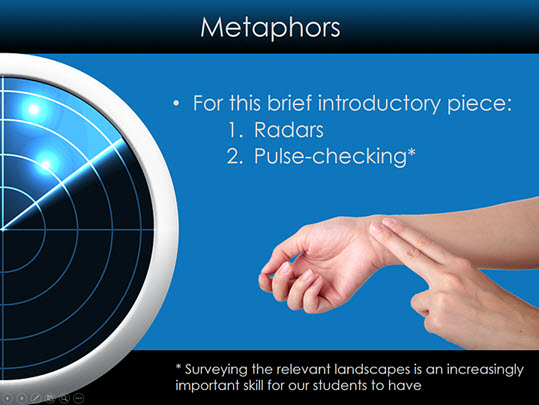
From DSC:
First a posting that got me to wondering about something that I’ve previously wondered about from time to time…
College of Business unveils classroom of the future — from biz.source.colostate.edu by Joe Giordano
Excerpt:
Equipped with a wall of 27 high-definition video screens as well as five high-end cameras, the newest classroom in Colorado State University’s College of Business is designed to connect on-campus and online students in a whole new way.
The College of Business unveiled on March 29 the “Room of the Future,” featuring Mosaic, an innovative technology – powered by mashme.io – that creates a blended classroom experience, connecting on-campus and online students in real time.
From DSC:
If the pedagogies could be worked out, this could be a very attractive model for many people in the future as it:
If the resulting increase in students could bring down the price of offering the course, will we see this model flourish in the near future?
For struggling colleges and universities, could this help increase the ROI of offering their classes on their physical campuses?
The technologies behind this are not cheap though…and that could be a show-stopper for this type of an experiment. But…thinking out loud again…what if there were a cheaper way to view a group of other people in your learning community? Perhaps there will be a solution using some form of Extended Reality (XR)…hmmm….
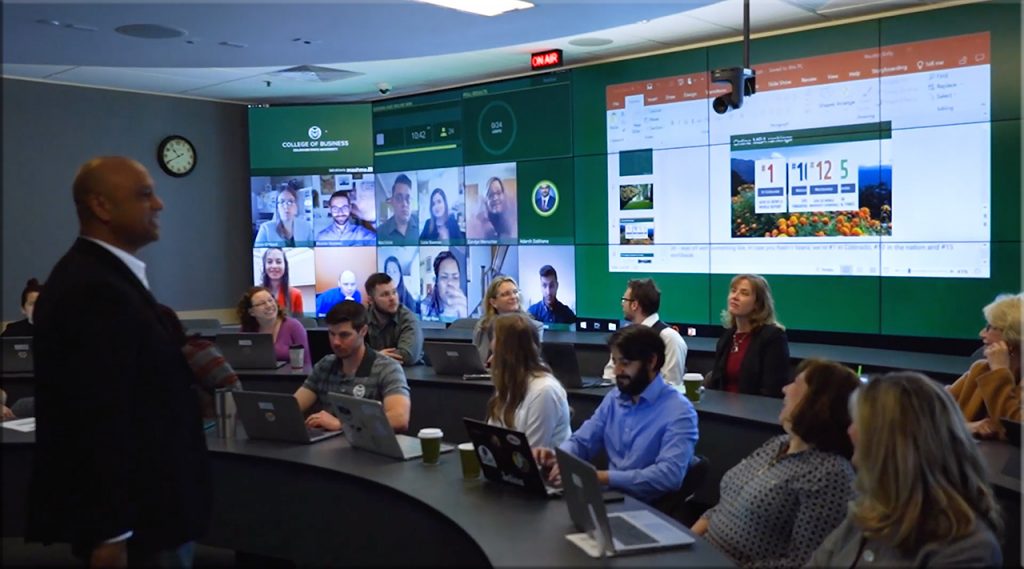
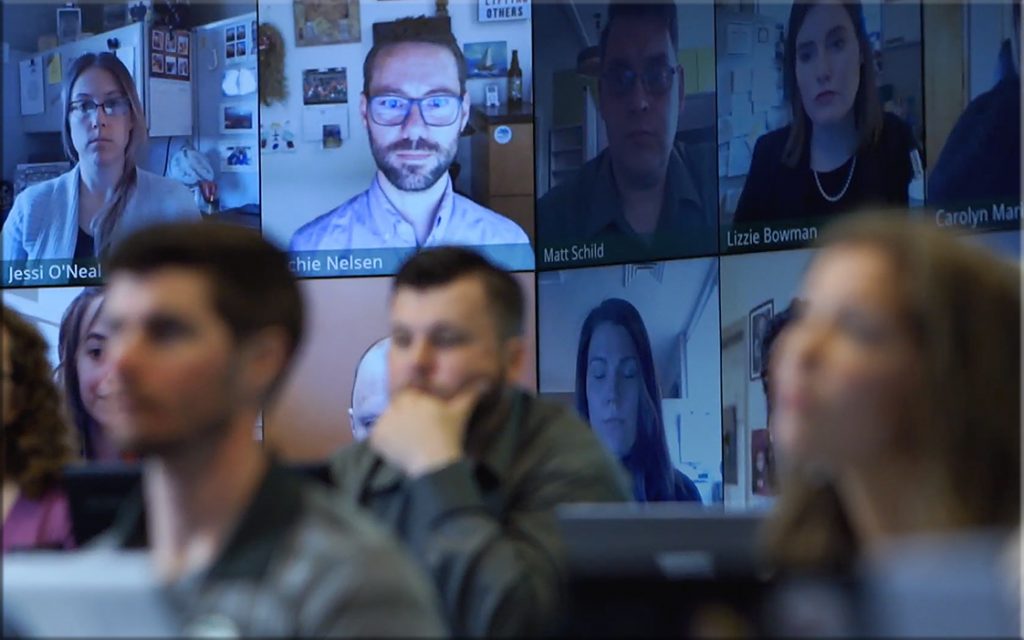

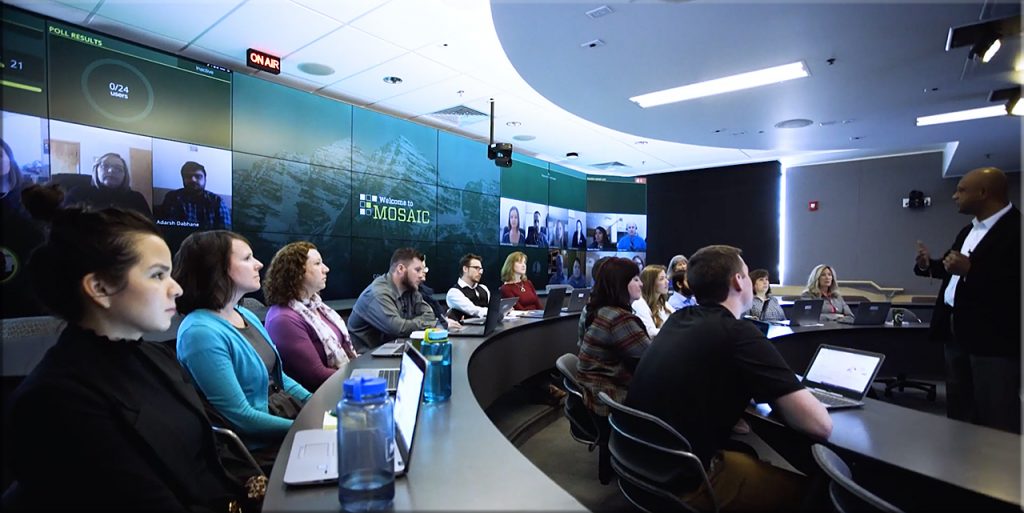
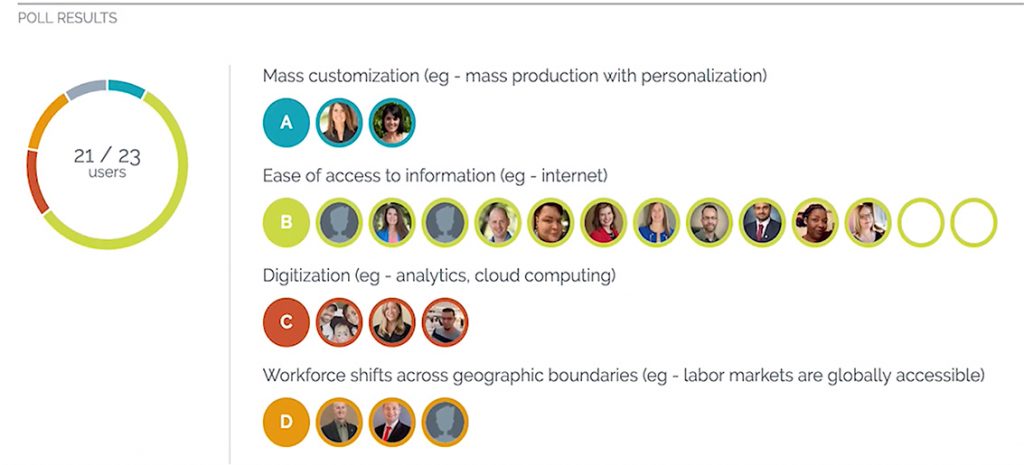
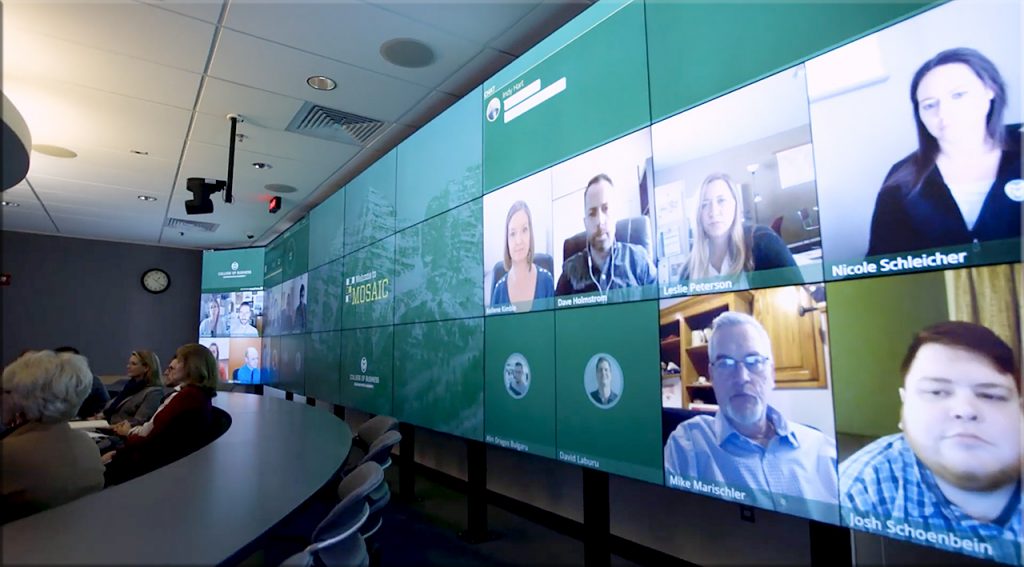
Also see:
Also see:
From a fairly recent e-newsletter from edsurge.com — though I don’t recall the exact date (emphasis DSC):
New England is home to some of the most famous universities in the world. But the region has also become ground zero for the demographic shifts that promise to disrupt higher education.
This week saw two developments that fit the narrative. On Monday, Southern Vermont College announced that it would shut its doors, becoming the latest small rural private college to do so. Later that same day, the University of Massachusetts said it would start a new online college aimed at a national audience, noting that it expects campus enrollments to erode as the number of traditional college-age students declines in the coming years.
“Make no mistake—this is an existential threat to entire sectors of higher education,” said UMass president Marty Meehan in announcing the online effort.
The approach seems to parallel the U.S. retail sector, where, as a New York Times piece outlines this week, stores like Target and WalMart have thrived by building online strategies aimed at competing with Amazon, while stores like Gap and Payless, which did little to move online, are closing stores. Of course, college is not like any other product or service, and plenty of campuses are touting the richness of the experience that students get by actually coming to a campus. And it’s not clear how many colleges can grow online to a scale that makes their investments pay off.
“It’s predicted that over the next several years, four to five major national players with strong regional footholds will be established. We intend to be one of them.”
University of Massachusetts President Marty Meehan
From DSC:
That last quote from UMass President Marty Meehan made me reflect upon the idea of having one or more enormous entities that will provide “higher education” in the future. I wonder if things will turn out to be that we’ll have more lifelong learning providers and platforms in the future — with the idea of a 60-year curriculum being an interesting idea that may come into fruition.
Long have I predicted that such an enormous entity would come to pass. Back in 2008, I named it the Forthcoming Walmart of Education. But then as the years went by, I got bumbed out on some things that Walmart was doing, and re-branded it the Forthcoming Amazon.com of Higher Education. We’ll see how long that updated title lasts — but you get the point. In fact, the point aligns very nicely with what futurist Thomas Frey has been predicting for years as well:
“I’ve been predicting that by 2030 the largest company on the internet is going to be an education-based company that we haven’t heard of yet,” Frey, the senior futurist at the DaVinci Institute think tank, tells Business Insider. (source)
I realize that education doesn’t always scale well…but I’m thinking that how people learn in the future may be different than how we did things in the past…communities of practice comes to mind…as does new forms of credentialing…as does cloud-based learner profiles…as does the need for highly efficient, cost-effective, and constant opportunities/means to reinvent oneself.
Also see:
Addendum:
74% of consumers go to Amazon when they’re ready to buy something. That should be keeping retailers up at night. — from cnbc.com
Key points (emphasis DSC)
“In New England, there will be between 32,000 and 54,000 fewer college-aged students just seven years from now,” Meehan said. “That means colleges and universities will have too much capacity and not enough demand at a time when the economic model in higher education is already straining under its own weight.” (Marty Meehan at WBUR)
Why AI is a threat to democracy — and what we can do to stop it — from technologyreview.com by Karen Hao and Amy Webb
Excerpt:
Universities must create space in their programs for hybrid degrees. They should incentivize CS students to study comparative literature, world religions, microeconomics, cultural anthropology and similar courses in other departments. They should champion dual degree programs in computer science and international relations, theology, political science, philosophy, public health, education and the like. Ethics should not be taught as a stand-alone class, something to simply check off a list. Schools must incentivize even tenured professors to weave complicated discussions of bias, risk, philosophy, religion, gender, and ethics in their courses.
One of my biggest recommendations is the formation of GAIA, what I call the Global Alliance on Intelligence Augmentation. At the moment people around the world have very different attitudes and approaches when it comes to data collection and sharing, what can and should be automated, and what a future with more generally intelligent systems might look like. So I think we should create some kind of central organization that can develop global norms and standards, some kind of guardrails to imbue not just American or Chinese ideals inside AI systems, but worldviews that are much more representative of everybody.
Most of all, we have to be willing to think about this much longer-term, not just five years from now. We need to stop saying, “Well, we can’t predict the future, so let’s not worry about it right now.” It’s true, we can’t predict the future. But we can certainly do a better job of planning for it.
From DSC:
In a next generation learning system, it would be sharp/beneficial to have a Netflix-like interface to check out potential functionalities that you could turn on and off (at will) — as one component of your learning ecosystem that could feature a setup located in your living room or office.
For example, put a Netflix-like interface to the apps out at eduappcenter.com (i.e., using a rolling interface at first, then going to a static page/listing of apps…again…similar to Netflix).
Towards a Reskilling Revolution: Industry-Led Action for the Future of Work — from weforum.org
As the Fourth Industrial Revolution impacts skills, tasks and jobs, there is growing concern that both job displacement and talent shortages will impact business dynamism and societal cohesion. A proactive and strategic effort is needed on the part of all relevant stakeholders to manage reskilling and upskilling to mitigate against both job losses and talent shortages.
Through the Preparing for the Future of Work project, the World Economic Forum provides a platform for designing and implementing intra-industry collaboration on the future of work, working closely with the public sector, unions and educators. The output of the project’s first phase of work, Towards a Reskilling Revolution: A Future of Jobs for All, highlighted an innovative method to identify viable and desirable job transition pathways for disrupted workers. This second report, Towards a Reskilling Revolution: Industry-Led Action for the Future of Work extends our previous research to assess the business case for reskilling and establish its magnitude for different stakeholders. It also outlines a roadmap for selected industries to address specific challenges and opportunities related to the transformation of their workforce.
See the PDF file / report here.
